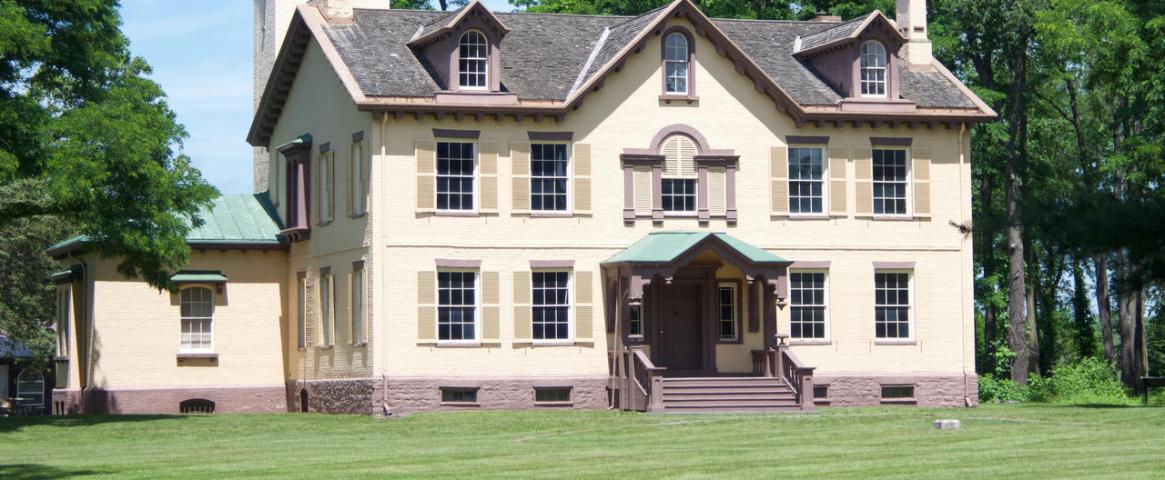By Jessica Andreone
On February 25th, the first eastern bluebird of the 1830 spring season was spotted in Kinderhook, New York. Two months later, on April 28th, apple trees started to flower. People in this area—starting with the Stockbridge-Munsee band of Mohicans before they were removed from the land—have kept track of these portents for thousands of years. Their arrival foretells the coming warm weather and their departure signifies an impending winter. By looking through the documents of the past-dated observations, old letters, and forms of nature writing — the USA-National Phenology Network (USA-NPN) and the Hawthorne Valley Farmscape Ecology Program (HVFEP) were able to obtain written records of blooming flowers and returning birds in Kinderhook that date back to before the Civil War.
The Martin Van Buren National Historic Site, located in Kinderhook, experiences the full range of northeast seasons. Depending on when they visit, tourists who come to see the home of the eighth president of the United States — a tan-yellow mansion that was built in 1797 — can expect to walk down a gravel drive surrounded by snow measured in feet, fragrant blossoming black locust trees, a fruiting pear tree, or fiery red leaves of fall. Behind the house is farmland and trails that lead to the Kinderhook Creek. No matter the time of year, the plants and animals at the site depend on the typical climate of each season to be in peak health.
People rely on phenology to indicate when they should start preparing soil for this year’s crop or when to break out their winter wardrobe. Signs like the first frost, bird migration, buds on trees, and changing leaf color are all indicators of seasonal change. If an area thaws too early in the season or if flowers bloom too early for pollinators to visit, farms will have a low crop yield and animals may starve.

Now, outside the bounds of the active organic farm, Martin Van Buren National Historic Site workers are monitoring trees and shrubs along a public trail to see how they react to climate change. With the data that is collected, the site hopes to restore an apple and pear orchard — similar to the one Martin Van Buren would have had in 1848 — to make the land as historic as the house. On the orchard’s site now is a plot of mixed forest that has claimed the fertile farm soil over the past hundred years.
“So, this might be a 10-year plan,” said Martin Van Buren National Historic Site Ranger Dawn Olson. “The part that’s already started is mowing the understory and/or starting to thin-out more of the more modern cherry trees.”
Anna Duhon, cultural research and outreach coordinator of the HVFEP, says the Martin Van Buren National Historic Site is a fitting place to compare the data from 1830 and beyond for a deeper understanding of the shift of the seasonal phenomena in the area.
Duhon, with her colleague Nellie Ostow, trained park rangers on how to monitor the 11 species, which make up 20 plants total, on the Martin Van Buren property. The plants chosen were those of interest to the USA-NPN, as well as a sycamore tree that has been alive and growing approximately for the last 120 years.
Rangers then host programs to show visitors how to monitor plants and wildlife to report data to the USA-NPN’s Nature’s Notebook. Through this online platform, anyone can observe and record nature, and that data will be used for research purposes. Duhon and her team will take the data collected from the Martin Van Buren National Historic Site and analyze it to see how climate change might be affecting life in Kinderhook.
According to Ranger Olson, the phenology trail is still in the beginning stages. “It’s a pilot program for the summer, so it’s just the staff. Then by next summer, we will develop a visitor experience so that we can offer a program where the visitors will be citizen scientists with us,” said Olson.
Though the historic revitalization project’s success all depends on how drastic the effects of climate change are on visiting pollinators and plant hibernation, blooming, and leafing. By monitoring the trail’s apple, black cherry, and pear trees at the Martin Van Buren National Historic Site, rangers can better adapt to altering conditions. The less alteration there is from climate change, the easier this project will be. The result: Transformed farmland around the mansion into a representation of what it would have been like in the late 19th century, and a community more aware of the life changing around them.
Jessica Andreone is a student of the Johns Hopkins University Master of Arts in Science Writing program. She is an environmental educator for the New York State Office of Parks, Recreation, and Historic Preservation. Check out her website-- jessandreone.com-- to look at more of her published works. Bird and nature lovers will love to follow her Instagram @a_jess_mess for photos of wildlife. Jessica can be reached by email at jandreone96@gmail.com.
This story was produced as part of NASW's David Perlman Summer Mentoring Program, which was launched in 2020 by our Education Committee. Anderone was mentored by JoAnna Wendel.
Main image: Lindenwald, home of President Martin Van Buren, located in Kinderhook, NY. Credit: Jessica Andreone.




